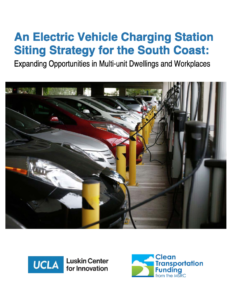Full Title: An Electric Vehicle Charging Station Siting Strategy for the South Coast: Expanding Opportunities in Multi-unit Dwellings and Workplaces
Author(s): J.R. DeShazo, James DiFilippo, Mark Hansen, Jason Karpman, Gregory Pierce
Publisher(s): UCLA Luskin Center for Innovation,
Publication Date: June 10, 2021
Full Text: Download Resource
Description (excerpt):
The South Coast Air Quality Management District (South Coast AQMD) 2016 Air Quality Management Plan places a strong emphasis on accelerating the transition to zero and near–zero emission vehicles as a means to reduce emissions. In support of this goal, the Mobile Source Air Pollution Reduction Review Committee (MSRC) is planning for the installation of electric vehicle service/charging equipment (EVSE) at two types of locations in the South Coast Air Basin: multi-unit dwellings (MUDs), such as apartments and condominiums, and workplaces.
These two types of locations have higher than usual hurdles for installing EVSE. Property owners and managers of MUDs and workplaces may not see the value of investing in electric vehicle (EV) charging because they do not necessarily drive plug-in electric vehicles (PEVs) themselves, nor is providing a PEV charging a core component of their business activities. However, some degree of participation from property owners and managers is necessary for EVSE installations to move forward. To compound the problem, PEV owners have little motivation to invest in equipment in such locations because it involves capital costs that they may not be able to recuperate. In order to overcome these motivational hurdles, financial incentives and technical assistance services are needed. Ensuring that these incentives and services actually reach likely PEV drivers is another challenge and requires robust and targeted outreach efforts.
This report seeks to support outreach efforts to property managers of MUDs and workplaces in the South Coast Air Basin where there is the greatest latent demand for charging. To that end, the report describes the development and use of two spatially resolved models, one of which ranks MUD properties according to the propensity of building occupants to purchase a PEV (assuming no barriers to charging), and the other of which ranks travel zones according to the additional electric miles that could be supported when plug-in hybrid vehicle (PHEV) drivers have access to workplace charging. The South Coast Air Basin, shown in Figure 1, is the largest region to which we have applied these models.
